Termički omotač
Thermal Envelope
Toplotna izolacija u zidovima i krovovima smanjuje prenos toplote između unutrašnjosti i spoljašnje sredine i pomaže u održavanju ugodne unutrašnje temperature. Omogućuje zdravije okruženje, bolji komfor i najvažnije, smanjuje račune za energiju. Izolacija pomaže da se unutrašnji prostor ohladi u letnjim mesecima i održi toplim tokom zime.
Thermal insulation in walls and roofs reduces heat transfer between the interior and the external environment and helps maintain a comfortable indoor temperature. It enables a healthier environment, better comfort, and most importantly, reduces energy bills. Insulation helps cool the interior space in the summer months and keeps it warm during winter.
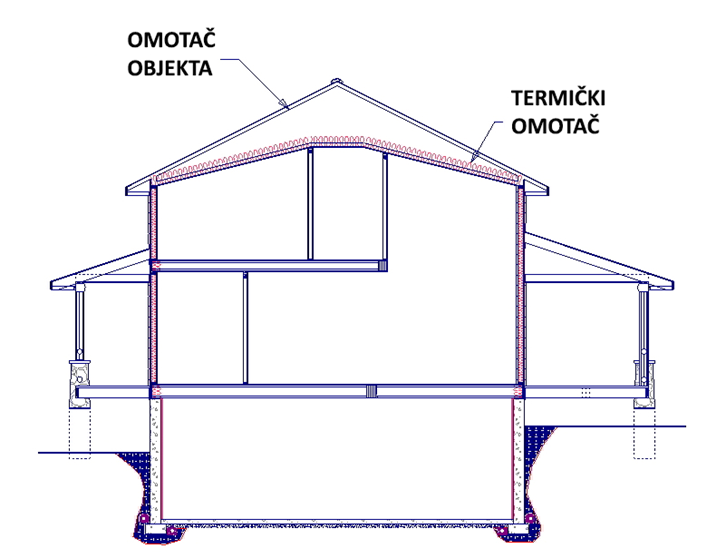
Postoji mnogo različitih termoizolacionih materijala od kojih se može odabrati staklena vuna, mineralna vuna, kamena vuna, ekspandirani ili ekstrudirani polistiren, celuloza, uretan ili fenolna penasta ploča i pamuk. Obično su u obliku amorfne vune ili krutih listova, ili ih je potrebno sipati na terenu. Izolacioni materijal bi trebao biti izabran imajući u vidu sledeće parametre - toplotne performanse, radni vek, požarna sigurnost, vlaga i kondenzacija, infiltracija vazduha i prednosti zaštite životne sredine. Izolaciju treba koristiti uvek sa materijalom za skladištenje toplote. U NZEB zgradama za grejanje ili hlađenje treba koristiti toplotnu izolaciju uzimajući u obzir problem kondenzacije. Kada se koriste materijali otporni na vlagu, oni bi uvek trebali biti na toploj strani izolacije.
There are many different thermal insulation materials to choose from, including glass wool, mineral wool, rock wool, expanded or extruded polystyrene, cellulose, urethane, or phenolic foam board, and cotton. They usually come in the form of amorphous wool or rigid sheets, or need to be poured on site. The insulation material should be chosen considering the following parameters - thermal performance, lifespan, fire safety, moisture and condensation, air infiltration, and environmental protection benefits. Insulation should always be used with a heat storage material. In NZEB buildings, thermal insulation should be used for heating or cooling, taking condensation issues into account. When using moisture-resistant materials, they should always be on the warm side of the insulation.
Tokom letnjih meseci u vrućim klimama, toplotna izolacija mora da se kombinuje sa efikasnom strategijom ventilacije noću (kada je hladnije) da bi se izbacila toplota. Obezbeđenje početne izolacije od svega nekoliko cm omogućava najveću dodatnu uštedu energije. Kako izolacioni materijal postaje postepeno deblji, ušteda energije se smanjuje i smanjuje sve dok nije gotovo beznačajna. Ne postoji nijedan univerzalni dizajn za termički omotač objekta. Kao i kod svih građevinskih projekata, termički omotač mora da se prilagodi klimi, lokaciji i nameni. Dizajn termičkog omotača zgrade je složen raspored svih slojeva potrebnih da bi građevina mogla da zadovolji uslove komfora njenih korisnika.
During the summer months in hot climates, thermal insulation must be combined with an efficient night ventilation strategy (when it is cooler) to expel heat. Providing initial insulation of just a few centimeters allows for the greatest additional energy savings. As the insulation material gradually becomes thicker, energy savings decrease until they are almost negligible. There is no universal design for a building's thermal envelope. As with all construction projects, the thermal envelope must be adapted to the climate, location, and purpose. The design of the building's thermal envelope is a complex arrangement of all the layers required for the building to meet the comfort conditions of its occupants.
Delovi termičkog omotača zgrade:
Parts of the Building's Thermal Envelope:
Netransparentni
Non-Transparent
- Spoljni zid
- Zid na dilataciji (između zgrada)
- Zidovi i međuspratne konstrukcije između grejanih prostorija različitih jedinica, različitih korisnika ili vlasnika
- Ravan krov iznad grejanog prostora
- Ravan krov iznad negrejanog prostora
- Kosi krov iznad grejanog prostora
- Kosi krov iznad negrejanog prostora
- Međuspratna konstrukcija iznad otvorenog prolaza
- Zid prema grejanom stepeništu
- Zid prema negrejanim prostorima
- Međuspratna konstrukcija ispod negrejanog prostora
- Međuspratna konstrukcija iznad negrejanog prostora
- Zid u tlu
- Pod na tlu
- Ukopana međuspratna konstrukcija
- External wall
- Dilatation wall (between buildings)
- Walls and intermediate floor structures between heated rooms of different units, different users or owners
- Flat roof above heated space
- Flat roof above unheated space
- Sloping roof above heated space
- Sloping roof above unheated space
- Intermediate floor structure above an open passage
- Wall towards heated staircases
- Wall towards unheated spaces
- Intermediate floor structure below unheated space
- Intermediate floor structure above unheated space
- Wall in the ground
- Floor on the ground
- Buried intermediate floor structure
Transparentni delovi
Transparent Parts
- Prozori, balkonska vrata grejanih prostorija i grejane zimske baste
- Stakleni krovovi, izuzimajući zimske bašte, svetlosne kupole
- Spoljna vrata
- Izlozi
- Staklene prizme
- Windows, balcony doors of heated rooms and heated winter gardens
- Glass roofs, excluding winter gardens, skylights
- External doors
- Display windows
- Glass prisms
Varijante termičkog omotača:
Variants of the Thermal Envelope:
- Termoizolacija sa unutrašnje strane elemenata termičkog omotača - ETICS
- Ventilacione fasade
- Termoizolacija sa unutrašnje strane elemenata termičkog omotača - ITICS
- Rešenje mešovitog tipa, koja je kombinacija prethodnih rešenja unutar jedne zgrade.
- Thermal insulation on the inner side of the thermal envelope elements - ETICS
- Ventilated facades
- Thermal insulation on the inner side of the thermal envelope elements - ITICS
- Mixed type solution, which is a combination of previous solutions within one building.
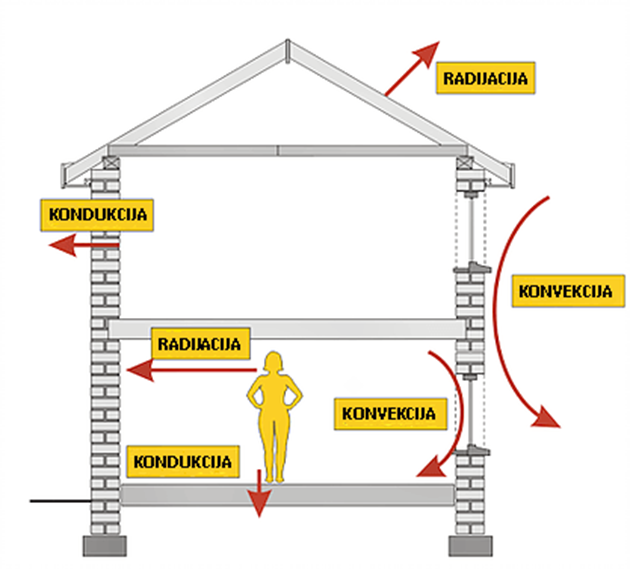
Pravilan izbor određenog termoizolacionog materijala je tesno povezan sa:
Proper selection of a specific thermal insulation material is closely related to:
- analizom svojstava termoizolacionih materijala u odnosu na svojstva ostalih materijala od kojih se izvode pojedini elementi konstrukcije,
- analizom položaja elementa konstrukcije u odnosu na okruženje i
- analizom termo - higrometrijskih uslova sredine
- analyzing the properties of thermal insulation materials in relation to the properties of other materials from which individual construction elements are made,
- analyzing the position of the construction element in relation to the environment, and
- analyzing the thermal - hygrometric conditions of the environment
Savremeni građevinski termoizolacioni materijali koji se koriste u izgradnji NZEB objekata treba da zadovolje niz strogo postavljenih zahteva, kao što su:
Modern construction thermal insulation materials used in the construction of NZEB buildings should meet a series of strictly set requirements, such as:
- niska zapreminska masa, tj. visoka poroznost;
- zadovoljavajuća mehanička čvrstoća;
- malo upijanje vode;
- dobra termoizolaciona svojstva;
- zadovoljavajuća provodljivost pare i gasova;
- otpornost na dejstvo mraza;
- hemijska i biološka postojanost;
- otpornost na dejstvo požara;
- netoksičnost;
- prihvatljiva cena koštanja;
- mogućnost recikliranja.
- low volumetric mass, i.e. high porosity;
- satisfactory mechanical strength;
- low water absorption;
- good thermal insulation properties;
- satisfactory vapor and gas permeability;
- frost resistance;
- chemical and biological stability;
- fire resistance;
- non-toxicity;
- acceptable cost;
- recyclability.
Nepoznavanje svojstava termoizolacionih materijala u praksi može dovesti do značajnog smanjenja efekata termoizolacije i pojave pratećih neželjenih efekata:
Lack of knowledge about the properties of thermal insulation materials in practice can lead to a significant reduction in insulation effects and the occurrence of accompanying undesirable effects:
- vlaga,
- truljenje materijala,
- buđ,
- klobučenje, ljuspanje i otpadanje paronepropusnih završnih slojeva i
- oštećenja usled dejstva mraza.
- moisture,
- material decay,
- mold,
- blistering, peeling, and falling off of vapor-tight finish layers, and
- damage due to frost.
Toplotna provodljivost
Thermal Conductivity
Izvan savršenog vakuma, svi materijali provode toplotu. Toplotna provodljivost ili lambda vrednost (λ) je termin koji se koristi da se opiše brzina kojom toplota (u vatima) prolazi kroz dužinu materijala pri datoj temperaturnoj razlici (W/mK). Toplotna provodljivost materijala zavisi od temperature i takođe varira u zavisnosti od sadržaja vlage i gustine. Varijacije u provodljivosti većine materijala mogu se javiti i zbog nehomogene prirode materijala na mikroskopskom ili ćelijskom nivou. U slučaju biljnih proizvoda, poput drveta, toplotna provodljivost takođe zavisi od smera i može biti značajno veća kada toplota teče u pravcu vlakna u odnosu na pravac normalan na vlakno.
Outside of a perfect vacuum, all materials conduct heat. Thermal conductivity or lambda value (λ) is the term used to describe the rate at which heat (in watts) passes through the length of a material at a given temperature difference (W/mK). The thermal conductivity of a material depends on temperature and also varies with moisture content and density. Variations in the conductivity of most materials can also occur due to the non-homogeneous nature of the material at a microscopic or cellular level. In the case of plant products, such as wood, thermal conductivity also depends on direction and can be significantly higher when heat flows along the grain direction compared to the direction perpendicular to the grain.
Kada odlučujete koja je lambda vrednost „ispravna“, vrednost koju treba koristiti je ona vrednost koju će materijal imati kada se ugradi i dostigne ravnotežni sadržaj vlage. ISO 10456: 2007 je međunarodni standard koji pruža metode za određivanje i deklarisanih i projektovanih toplotnih vrednosti za homogene građevinske materijale, zajedno sa postupcima za pretvaranje vrednosti dobijenih pod jednim setom uslova u one koji važe za drugi skup uslova. Ovi postupci su potvrđeni za temperaturni opseg projektovanog ambijenta koji utiče na većinu zgrada (–30 ° C do + 60 ° C).
When deciding which lambda value is "correct", the value to use is the one the material will have when installed and reaches equilibrium moisture content. ISO 10456: 2007 is an international standard that provides methods for determining both declared and design thermal values for homogeneous building materials, along with procedures for converting values obtained under one set of conditions to those applicable to another set of conditions. These procedures are confirmed for the temperature range of the designed environment affecting most buildings (–30 °C to +60 °C).
Kada se koriste prirodni proizvodi za izolaciju, kao što su bala slame, mora se biti oprezan u odnosu na projektovanu lambda vrednost. Beleže se varijacije u gustoći bala slame od 100 kg/m 3 do 130 kg/m 3 i toplotnoj provodljivosti koja varira u rasponu od 0,05 W/mK do 0,065 W/mK. Dalje, organski materijali kao što su slama, pluta i sl. često su visoko higroskopni i zato imaju nelinearne karakteristike provodljivosti.
When using natural products for insulation, such as straw bales, caution must be exercised regarding the design lambda value. Density variations in straw bales are recorded from 100 kg/m³ to 130 kg/m³ and thermal conductivity varies from 0.05 W/mK to 0.065 W/mK. Furthermore, organic materials such as straw, cork, etc. are often highly hygroscopic and therefore have non-linear conductivity characteristics.
Koeficijent prolaza toplote
Heat Transfer Coefficient
Koeficijent prolaza toplote (poznat i kao U-vrednost) opisuje brzinu prenosa toplote (u vatima) kroz jedan kvadratni metar građevinske površine za svaki stepen razlike temperature u strukturi (W/m²K). Termički otpor (R) je recipročan od U-vrednosti, a dobro izolovani elementi sa visokim toplotnim otporom će imati odgovarajuće nizak koeficijent prolaza toplote. Gubici usled toplotne konvekcije, toplotne provodljivosti i donekle toplotnog zračenja uzimaju se u obzir unutar U-vrednosti. U homogenim građevinskim elementima, vrednost U može se jednostavno izračunati kao recipročna suma otpora pojedinih slojeva, uključujući otpor površinskih slojeva vazduha sa obe strane elementa (koji su izloženi sobnom ili spoljnjem vazduhu).
The heat transfer coefficient (also known as the U-value) describes the rate of heat transfer (in watts) through one square meter of building surface for each degree of temperature difference in the structure (W/m²K). Thermal resistance (R) is the reciprocal of the U-value, and well-insulated elements with high thermal resistance will have a correspondingly low heat transfer coefficient. Losses due to thermal convection, thermal conductivity, and to some extent thermal radiation are taken into account within the U-value. In homogeneous building elements, the U-value can be simply calculated as the reciprocal sum of the resistance of individual layers, including the resistance of the air surface layers on both sides of the element (which are exposed to indoor or outdoor air).
gde je:
where:
- R si je površinski otpor unutrašnjeg sloja vazduha
- R se je površinski otpor spoljnjeg sloja vazduha.
- R si is the surface resistance of the indoor air layer
- R se is the surface resistance of the outdoor air layer.
Površinske vrednosti toplotnog otpora R si i R se nalaze se u EN ISO 6946: 2007. U-vrednosti u osnovi opisuju jednodimenzionalni toplotni tok. Nakon što se odrede U vrednosti svakog elementa konstrukcije, moguće je izračunati jednodimenzionalno toplotno opterećenje (PT) kroz svaki element prema jednačini:
The surface thermal resistance values R si and R se are found in EN ISO 6946: 2007. U-values essentially describe one-dimensional heat flow. Once the U-values of each construction element are determined, it is possible to calculate the one-dimensional thermal load (PT) through each element according to the equation:
P Tj je toplotno opterećenje jednodimenzionalnog prenosa, kroz j-ti element (W) U j je koeficijent prolaza toplote j-og elementa, A j je spoljna površina j-tog elementa, T i -T e je razlika između unutrašnje i spoljne granične temperature (K) tokom datog perioda vršnog opterećenja. Kada se gubici prenosa ne odnose na spoljni vazduh, već na zemlju ili delimično zagrejanu (tampon) zonu, u jednačini 4 mora se primeniti korekcioni faktor temperature () da bi se umanjila stopa gubitaka u odnosu na spoljnu temperaturu vazduha.
P Tj is the one-dimensional heat load through the j-th element (W) U j is the heat transfer coefficient of the j-th element, A j is the external surface area of the j-th element, T i -T e is the difference between the indoor and outdoor boundary temperatures (K) during the given peak load period. When transfer losses do not relate to external air but to the ground or a partially heated (buffer) zone, a temperature correction factor () must be applied in the equation to reduce the rate of losses in relation to the external air temperature.
Izraz stepen sati grejanja (G t ) koristi se za opisivanje vremena (h ili Kh) i stepena (K) zagrevanja potrebnog za datu klimatsku lokaciju (kKh). Jednostavno rečeno, stepen sati grejanja su razlika između temperature spoljnjeg vazduha i unutrašnje referentne temperature (K), iznad koje se pretpostavlja da dopunsko grejanje nije potrebno, pomnoženo sa vremenskim trajanjem sezone grejanja (h ili Kh ). Jednom kada su (G t ) i (f t ) poznati, godišnji jednodimenzionalni toplotni gubitak (K T, 1D ) kroz bilo koji element može se izračunati prema jednačini:
The term heating degree hours (G t) is used to describe the time (h or Kh) and degree (K) of heating required for a given climatic location (kKh). Simply put, heating degree hours are the difference between the outside air temperature and the indoor reference temperature (K), above which supplemental heating is assumed to be unnecessary, multiplied by the duration of the heating season (h or Kh). Once (G t) and (f t) are known, the annual one-dimensional heat loss (K T, 1D) through any element can be calculated according to the equation:
Q Tj je godišnji jednodimenzionalni gubitak toplotne energije kroz j-ti element (kWh / m2.a), G t su klimatski zavisni stepen sati grejanja (kKh). Da bi se izračunali ukupni godišnji toplotni gubici (K T ) kroz celokupni termički omotač, dodatni dvodimenzionalni (i potencijalno trodimenzionalni) toplotni mostovi koji se javljaju na geometrijskim presecima i prodorima u termičkom omotaču moraju se dodati u jednačinu.
Q Tj is the annual one-dimensional heat loss through the j-th element (kWh/m².a), G t are climate-dependent heating degree hours (kKh). To calculate the total annual heat losses (K T) through the entire thermal envelope, additional two-dimensional (and potentially three-dimensional) thermal bridges occurring at geometric intersections and penetrations in the thermal envelope must be added to the equation.
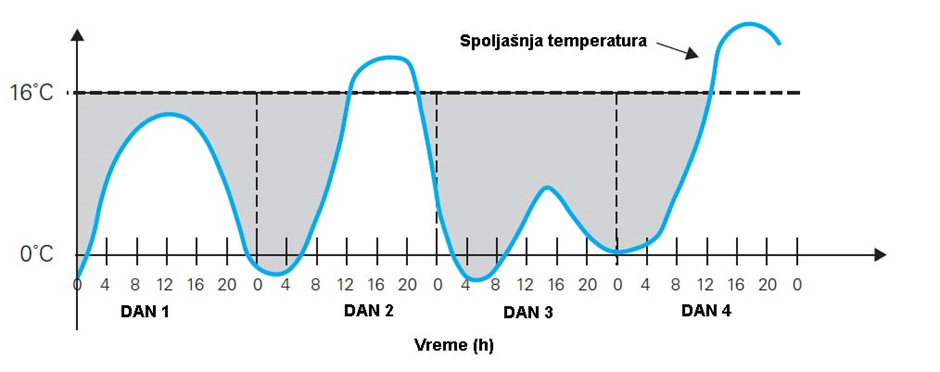
Izračunavanje stepena sati grejanja (G t ) na osnovu unutrašnje osnovne temperature od 16 ° C kao gornje granice, iznad koje grejanje ne bi bilo potrebno zbog dostupnosti unutrašnjih i pasivnih dobitaka.
Calculating the heating degree hours (G t) based on an indoor base temperature of 16 °C as the upper limit, above which heating would not be necessary due to the availability of internal and passive gains.
Principi toplotne mase i toplotne difuznosti
Principles of Thermal Mass and Thermal Diffusivity
Tipovi konstrukcija mogu se u velikoj meri kategorisati kao lake, srednje teške i teške, u skladu sa nivoom raspoložive toplotne mase. Svaka od ovih vrsta građevina ima niz prednosti i nedostataka, a konačan izbor može biti diktiran većim brojem faktora, uključujući geografski položaj zgrade, mikroklimatske faktore, broj korisnika unutar zgrade, građevinske propise i ograničenja planiranja. Teške konstrukcije imaju tendenciju da imaju veliku toplotnu masu, mada se materijali sa velikom toplotnom masom mogu ugraditi u lagane konstrukcije. Termička masa ili termička inercija su pojmovi koji se obično koriste za opisivanje sposobnosti građevinskih materijala da skladište toplotu. Jednostavno rečeno, toplotni kapacitet materijala se kvantifikuje kao produkt gustine materijala () i njegovog specifičnog toplotnog kapaciteta (C p ). Ovo je poznato kao zapreminski specifični toplotni kapacitet (C p ).
Types of constructions can be largely categorized as light, medium-heavy, and heavy, according to the level of available thermal mass. Each of these types of buildings has a range of advantages and disadvantages, and the final choice may be dictated by a larger number of factors, including the geographical location of the building, microclimatic factors, the number of users within the building, building regulations, and planning constraints. Heavy constructions tend to have high thermal mass, although materials with high thermal mass can be incorporated into light constructions. Thermal mass or thermal inertia are terms commonly used to describe the ability of building materials to store heat. Simply put, the thermal capacity of a material is quantified as the product of the material's density (ρ) and its specific heat capacity (C p). This is known as volumetric specific heat capacity (C p).
C p je zapreminski specifični toplotni kapacitet (J/m 3 K ili kWh/m 3 K). C p je specifični toplotni kapacitet (J / kg.K). Zapreminski specifični toplotni kapacitet stoga opisuje koliko toplote ili energije (kWh) kubni metar materijala (m 3 ) može da skladišti povećanjem temperature za jedan stepen (K). Izraz „aktivna“ ili „efektivna“ toplotna masa odnosi se na termičku masu koja se nalazi unutar termičkog omotača zgrade i direktno je spojena sa unutrašnjim vazduhom (tj. nije termički odvojena izolacijom, podnim oblogama i servisnim šupljinama).
C p is volumetric specific heat capacity (J/m³K or kWh/m³K). C p is specific heat capacity (J/kgK). Therefore, volumetric specific heat capacity describes how much heat or energy (kWh) a cubic meter of material (m³) can store by increasing its temperature by one degree (K). The term “active” or “effective” thermal mass refers to the thermal mass located within the building's thermal envelope and directly connected to the indoor air (i.e., not thermally separated by insulation, floor coverings, and service cavities).
Toplotna difuzivnost (A-alfa) je usko povezano svojstvo sa termičkom masom i opisuje brzinu kojom se toplota prenosi kroz dubinu preseka nekog materijala. Toplotna difuzivnost (m 2 /s) izračunava se deljenjem toplotne provodljivosti materijala (W/mK) sa specifičnim zapreminskim toplotnim kapacitetom (pri konstantnom pritisku). Kao takva, ona opisuje sposobnost materijala da provodi toplotnu energiju u odnosu na sposobnost skladištenja toplotne energije. Tako će materijali sa visokim toplotnim kapacitetom skladištenja i niskom provodljivošću imati niske stope toplotne difuzije.
Thermal diffusivity (A-alpha) is a closely related property to thermal mass and describes the rate at which heat is transferred through the depth of a material cross-section. Thermal diffusivity (m²/s) is calculated by dividing the thermal conductivity of the material (W/mK) by the specific volumetric heat capacity (at constant pressure). As such, it describes the ability of a material to conduct thermal energy relative to its ability to store thermal energy. Therefore, materials with high thermal storage capacity and low conductivity will have low rates of thermal diffusivity.
- je toplotna difuzivnost (m 2 /s),
- λ je toplotna provodljivost (W/mK),
- Cp je specifični toplotni kapacitet (J/kgK), a je gustina (kg/m 3 ).
- α is thermal diffusivity (m²/s),
- λ is thermal conductivity (W/mK),
- Cp is specific heat capacity (J/kgK), and ρ is density (kg/m³).
Kašnjenje oscilacije temperature () je vreme kašnjenja prenosa toplote (sati) koje je posledica toplotne difuznosti određenog građevinskog elementa. Faktor prigušenja amplitude oscilacija temperature (D f ) je odnos kojim se amplituda sinusnog talasa spoljne temperature prigušuje kao rezultat specifičnog toplotnog kapaciteta materijala.
Temperature oscillation delay (τ) is the delay time of heat transfer (hours) due to the thermal diffusivity of a specific building element. The temperature oscillation amplitude damping factor (D f) is the ratio by which the amplitude of the external temperature sinusoidal wave is dampened as a result of the material's specific heat capacity.
D f = T i,amp /T e,amp
D f = T i,amp /T e,amp
- T e , amp je amplituda spoljnjeg temperaturnog sinusnog talasa (K)
- T i , amp je amplituda unutrašnjeg temperaturnog sinusnog talasa (K)
- T e , amp is the amplitude of the external temperature sinusoidal wave (K)
- T i , amp is the amplitude of the internal temperature sinusoidal wave (K)
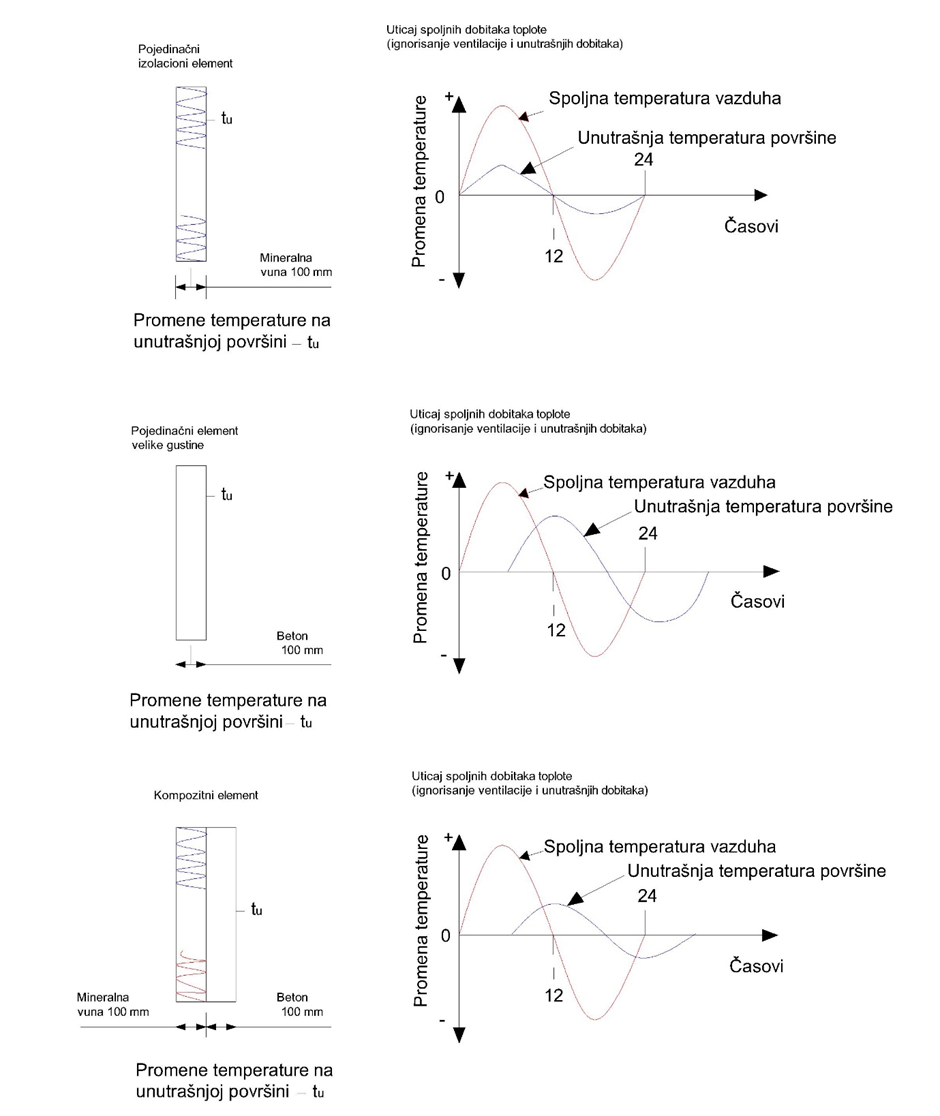
Treba napomenuti da se i kašnjenje i smanjenje faktora odnose na teorijska svojstva određenog materijala ili konstrukcije i ne uzimaju u obzir efekte dodatnih promenljivih kao što su solarni dobitak i izmene vazduha koji će uticati na ponašanje stvarnog objekta. Stoga se stvarno vreme kašnjenja i prigušivanje koje nastaju između vršnih unutrašnjih i spoljašnjih temperatura u sobi ili zgradi mogu tačno izračunati samo pomoću dinamičkih metoda simulacije koje uzimaju u obzir sve uticajne faktore.
It should be noted that both delay and reduction factors relate to the theoretical properties of a particular material or construction and do not take into account the effects of additional variables such as solar gain and air changes that will affect the behavior of the actual building. Therefore, the actual delay time and damping that occur between peak indoor and outdoor temperatures in a room or building can only be accurately calculated using dynamic simulation methods that take all influencing factors into account.
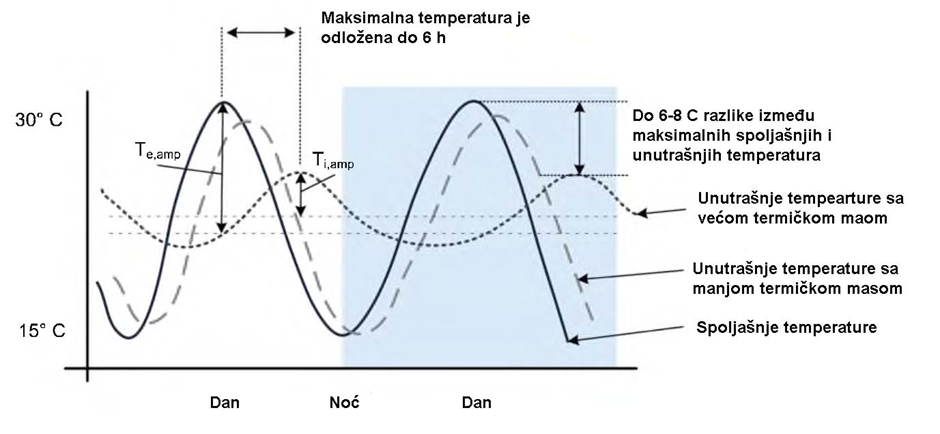
Kašnjenje oscilacije temperature () i faktor prigušenja amplitude oscilacija temperature (D f ) za materijale sa velikom i malom termičkom masom.
Temperature oscillation delay () and temperature oscillation amplitude damping factor (D f) for materials with high and low thermal mass.
Toplotna masa u praksi
Thermal Mass in Practice
Dodavanje toplotne mase unutar izolovanog omotača zgrade pomaže da se ublaže ekstremi dnevnih unutrašnjih temperaturnih ciklusa, čineći na taj način prosečnu unutrašnju temperaturu stabilnijom tokom dnevnog ciklusa, a zgradu obično ugodnijom za stanovanje. Termalna masa je manje važna, ali ipak korisna na lokacijama sa umerenijom letnjom klimom.
Adding thermal mass within the insulated envelope of the building helps to mitigate the extremes of daily indoor temperature cycles, making the average indoor temperature more stable during the daily cycle, and generally making the building more comfortable to live in. Thermal mass is less important but still useful in locations with a more temperate summer climate.
Mora se naglasiti da toplotna masa ne obezbeđuje slobodno hlađenje (free cooling) ili energiju za grejanje, a svako smanjenje opterećenja za grejanje mora se pripisati poboljšanom faktoru iskorišćenja solarnih i internih dobitaka. U hladnim kontinentalnim klimama tokom grejne sezone, zgrade NZEB-a ostvaruju veoma veliku iskorišćenost solarnih i unutrašnjih dobitaka (tj. gotovo svi dobici su korisni), pa će stoga dalja poboljšanja putem termalne mase biti marginalna. U situacijama kada su solarni dobici mali i koristi se dodatno grejanje, toplotna masa može čak povećati zimske potrebe za grejanjem. Materijali koji skladište toplotu obično takođe apsorbuju vodenu paru, a dodatna energija promene faze povezana sa oslobađanjem apsorbovane vlage može da poveća zahtev za toplotnim potrebama.
It must be emphasized that thermal mass does not provide free cooling or heating energy, and any reduction in heating load must be attributed to an improved utilization factor of solar and internal gains. In cold continental climates during the heating season, NZEB buildings achieve very high utilization of solar and internal gains (i.e., almost all gains are useful), so further improvements through thermal mass will be marginal. In situations where solar gains are low and additional heating is used, thermal mass can even increase winter heating requirements. Materials that store heat usually also absorb water vapor, and the additional phase change energy associated with releasing absorbed moisture can increase the heating requirements.
Pri određivanju koliko je toplotne mase pogodno, potrebno je uzeti u obzir lokaciju i profil stanovanja unutar zgrade, kao i njenu sposobnost da tokom letnjih meseci oslobađa neželjenu toplotu, jer svaki višak toplote koji se skladišti tokom toplijih perioda može izazvati pregrevanje osim ako se ne može potpuno osloboditi tokom dnevnog ciklusa od 24 sata.
When determining how much thermal mass is appropriate, it is necessary to consider the location and living profile within the building, as well as its ability to release unwanted heat during the summer months, because any excess heat stored during warmer periods can cause overheating unless it can be fully released during the 24-hour daily cycle.
EPS
EPS
Ekspandirani polistiren ili EPS je najpopularniji i najjeftiniji izolacioni materijal koji se trenutno koristi u sistemima izolacije spoljnih zidova, a koji su trenutno dostupni na tržištu. Beli EPS koji smo svi dobro poznavali godinama je osnova spoljne izolacije i ima tipičnu toplotnu provodljivost od 0,037 do 0,040 W/mK. U novije vreme zamenio ga je sivi EPS, koji je pojačan grafitom i ima veću vrednost provodljivosti od oko 0,031 W/mK. To efektivno znači da dobijate iste performanse od tanjih profila. EPS se smatra jednostavnim za rad. Lagan je, lako se reže, ali je prilično čvrst. Kako je on uobičajen izolacioni materijal, dostupan je u različitim debljinama.
Expanded polystyrene or EPS is the most popular and cheapest insulation material currently used in external wall insulation systems available on the market. The white EPS that we have all been familiar with for years is the basis of external insulation and has a typical thermal conductivity of 0.037 to 0.040 W/mK. Recently, it has been replaced by gray EPS, which is enhanced with graphite and has a higher conductivity value of around 0.031 W/mK. This effectively means you get the same performance from thinner profiles. EPS is considered easy to work with. It is lightweight, easy to cut, but quite sturdy. As it is a common insulation material, it is available in various thicknesses.

Mineralna vuna
Mineral Wool
Drugi poznati materijal, mineralna vuna nalazi se na nižem troškovnom delu spektra i ima toplotnu provodljivost u području od 0,036 W/mK. Ima najbolje karakteristike za zaštitu od požara - mineralna vuna ne gori. To je jedan od razloga zašto se često koristi u socijalnim stambenim i poslovnim višespratnicama, ali i kao protivpožarna barijera u drugim projektima. Smatra se da je malo teža za obradu jer se teže reže. Takođe treba da bude suva tokom ugradnje. U skladu sa tim, ako i dođe u kontakt sa vlagom, njene karakteristike će se povratiti nakon što se obezbedi potpuno isušenje. Mineralna vuna ima veoma dobru paropropusnost - što znači da bilo koja vlaga/vodena para u strukturi može neometano preći na spoljnu površinu. Kao i kod svih izolacija, paropropusnost se održava samo ako je završni sloj sam paropropusan.
Another well-known material, mineral wool is found at the lower end of the cost spectrum and has a thermal conductivity in the range of 0.036 W/mK. It has the best characteristics for fire protection - mineral wool does not burn. This is one of the reasons why it is often used in social housing and commercial high-rise buildings, as well as a fire barrier in other projects. It is considered a bit harder to handle as it is more difficult to cut. It also needs to be dry during installation. Accordingly, if it comes into contact with moisture, its characteristics will recover once it is fully dried. Mineral wool has very good vapor permeability - meaning that any moisture/water vapor in the structure can pass unobstructed to the outer surface. As with all insulation, vapor permeability is maintained only if the finish layer itself is vapor permeable.
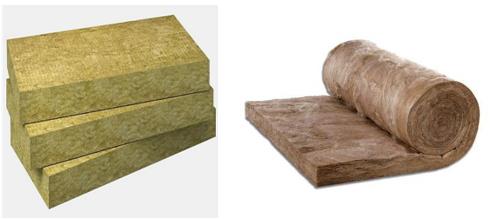
XPS
XPS
Proizvodi se od 1940-ih, proces ekstrudiranja penastog stiropora rezultira materijalom s ravnomerno malim zatvorenim ćelijama, što strukturi daje vrhunsku čvrstinu, čineći je visoko otpornom na kompresiju sa toplotnom provodljivošću od oko 0,34 W/mK. XPS ima prirodnu otpornost na kišu, sneg, mraz i vodenu paru i izuzetno je stabilan materijal, zadržavajući svoje početne izolacione performanse i fizički integritet u izloženim uslovima tokom dugog trajanja. Pravilno postavljene, XPS ploče imaju vek trajanja koji je uporediv sa životnom vekom zgrade.
Produced since the 1940s, the process of extruding foamed polystyrene results in a material with uniformly small closed cells, giving the structure superior strength, making it highly resistant to compression with a thermal conductivity of around 0.34 W/mK. XPS has natural resistance to rain, snow, frost, and water vapor and is an extremely stable material, maintaining its initial insulation performance and physical integrity in exposed conditions over a long duration. Properly installed, XPS boards have a lifespan comparable to the life of the building.
Drveno vlakno
Wood Fiber
Izolacija spoljnjih zidova od drvenih vlakana ima najbolje “zelene” karakteristike. Sa toplotnom provodljivošću u području od 0,039 W/mK, potrebna vam je veća debljina da biste postigli ekvivalentne toplotne performanse. Takođe, malo je skuplja od mineralne vune, u potpunosti je paropropusna (opet kada se koristi u kombinaciji sa odgovarajućim završnim slojevima i lepkovima) i češće se koristi na drvenim konstrukcijama. Vlaknasta struktura drveta omogućava joj da akumulira i skladišti toplotu tokom dana, a zatim oslobađa noću kada temperatura opadne, odgađajući pojavu kondenzacije na površini i tako čineći unutrašnju površinu manje podložnom buđi i rastu algi.
External wall insulation made of wood fiber has the best "green" characteristics. With a thermal conductivity in the range of 0.039 W/mK, you need a greater thickness to achieve equivalent thermal performance. It is also slightly more expensive than mineral wool, is fully vapor permeable (again when used in combination with appropriate finish layers and adhesives), and is more commonly used on wooden structures. The fibrous structure of wood allows it to accumulate and store heat during the day, and then release it at night when the temperature drops, delaying the onset of condensation on the surface and thus making the interior surface less prone to mold and algae growth.

Završni sloj
Finish Layer
Postoje opcije na bazi osnovnih akrila i maltera na bazi silikona. Akrilni malter sadrži akrilnu smolu koja je otporna na vodu i manje sklona pucanju. Generalno je jeftinije od ostalih opcija jer zahteva samo jedan premaz. Fleksibilan je, dugotrajan i dobro drži boju. Međutim, nije paropropusan, pa nema smisla koristiti ga sa paropropusnim izolacionim materijalima poput drvenih vlakana ili kamene vune.
There are options based on basic acrylics and silicone-based plasters. Acrylic plaster contains acrylic resin which is water-resistant and less prone to cracking. Generally, it is cheaper than other options as it requires only one coat. It is flexible, durable, and holds color well. However, it is not vapor permeable, so it makes no sense to use it with vapor permeable insulation materials such as wood fiber or mineral wool.
Malter na bazi silicijuma je postao mnogo popularniji poslednjih godina. Poput akrila, fleksibilan je i ne puca. Možete da dobijete silicijumske maltere sa osobinom samočišćenja u cilju smanjenja troškova održavanja. Stručnjaci favorizuju ove maltere za projekte u neposrednoj blizini autoputa, gde se čestice mogu zakačiti za zidove. Otpornost na vodu takođe je odlična opcija za obalne regije, gde so može da napadne završni sloj fasade. Ključna karakteristika silikonskih maltera je njihova paropropusnost, što ih čini prirodnim spojem sa izolacijom spoljenjeg zida koji “diše”. Neki sadrže antimikrobno sredstvo koje inhibira rast buđi i algi. Ovi biocidi su vrlo korisni u sprečavanju promene boje koja se s vremenom može javiti.
Silicone-based plaster has become much more popular in recent years. Like acrylic, it is flexible and does not crack. You can get silicone plasters with self-cleaning properties to reduce maintenance costs. Experts favor these plasters for projects close to highways, where particles can stick to the walls. Water resistance is also an excellent option for coastal regions where salt can attack the facade's finish layer. The key feature of silicone plasters is their vapor permeability, which makes them a natural fit with external wall insulation that “breathes”. Some contain an antimicrobial agent that inhibits the growth of mold and algae. These biocides are very useful in preventing discoloration that can occur over time.
Ispravna završna obrada jednako je važna kao i ispravna vrsta izolacije. Potrebno je odvojiti vreme za procenu zgrade, uzimajući u obzir gde se ona nalazi i čemu će biti izložena pre nego što se izabere najprikladniji proizvod.
The correct finish is as important as the correct type of insulation. It is necessary to take time to assess the building, considering where it is located and what it will be exposed to before selecting the most suitable product.